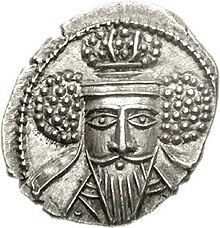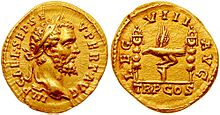Vologases V
| Vologases V 𐭅𐭋𐭂𐭔 | |
|---|---|
| King of Kings | |
 Coin of Vologases V,Ecbatanamint | |
| King ofArmenia | |
| Reign | 180 – 191 |
| Predecessor | Sohaemus |
| Successor | Khosrov I |
| King of theParthian Empire | |
| Reign | 191 – 208 |
| Predecessor | Vologases IV |
| Successor | Vologases VI |
| Died | 208 |
| Issue | |
| Dynasty | Arsacid dynasty |
| Father | Vologases IV |
| Religion | Zoroastrianism |
Vologases V(Parthian:𐭅𐭋𐭂𐭔Walagash) wasKing of Kingsof theParthian Empirefrom 191 to 208. As king ofArmenia(r. 180–191), he is known asVologases II.Not much is known about his period of kingship of Armenia, except that he put his sonRev I(r. 186–216) on theIberianthrone in 189. Vologases succeeded his fatherVologases IVas king of the Parthian Empire in 191; it is uncertain if the transition of power was peaceful or if Vologases took the throne in a civil war. When Vologases acceded the Parthian throne, he passed the Armenian throne to his sonKhosrov I(r. 191–217).
Vologases' reign was marked by war with theRoman Empire,lasting from 195 to 202, resulting in the brief capture of the Parthian capital ofCtesiphon,and reaffirmation of Roman rule in Armenia and northernMesopotamia.At the same time, internal conflict took place in the Parthian realm, with the local Persian princePabagseizingIstakhr,the capital of the southern Iranian region ofPersis.
Name
[edit]Vologases is theGreekandLatinform of theParthianWalagaš(𐭅𐭋𐭂𐭔). The name is also attested inNew PersianasBalāshandMiddle PersianasWardākhsh(also spelledWalākhsh). The etymology of the name is unclear, althoughFerdinand Justiproposes thatWalagaš,the first form of the name, is a compound of words "strength" (varəda), and "handsome" (gašorgešin Modern Persian).[1]
Biography
[edit]King of Armenia
[edit]During Vologases' early life, he became the ruler ofArmenia,succeedingSohaemus.[2][3][4]Throughout the 1st and 2nd-centuries, the Armenian throne was usually occupied by a close relative of the ParthianKing of Kings,who held the title of "Great King of Armenia".[5][a]Unlike the previous eight Arsacid princes who ruled Armenia, Vologases was able to ensure that hisdescendants ruled on the Armenian throne;they would rule the country until theSasanianabolition of the Armenian throne in 428.[2]
In 189, he also imposed his sonRev I(whose mother was the sister of thePharnavazidrulerAmazasp) on theIberianthrone.[8]Hisdescendantswould rule Iberia until 284 when it was replaced by another Parthian family, theMihranids.[9]
King of the Parthian Empire
[edit]In 191 after the death of his fatherVologases IV,Vologases ascended the Parthian throne and passed the Armenian throne to his sonKhosrov I(r. 191–217).[2][3]It is uncertain if the transition of power was peaceful or marred in a civil war.[1][10]His claim to the throne, however, was not uncontested; a rival king,Osroes II(190), had set himself up inMediaeven before the death of Vologases IV, but Vologases appears to have quickly put him down.[11]

Vologases supported EmperorPescennius Niger(r. 193–194) in his struggle for the Roman throne against EmperorSeptimius Severus(r. 193–211) in 192–193, during theYear of the Five Emperors.Furthermore, he also intervened in the affairs of the Roman vassal states in northernMesopotamia—AdiabeneandOsroene.Because of this, Septimius Severus, who emerged victorious in the struggle, attacked the Parthian Empire in 195.[12]Severus advanced into Mesopotamia, made Osroene a Roman province, and captured the Parthian capitalCtesiphonin 199.[1][12]At the same time, revolts were occurring in the Parthian provinces of Media andPars.[13]Septimius Severus now declared himselfParthicus Maximus( "great victor in Parthia" ). He was, however, unable to maintain his conquests, due to lack of food supplies and reinforcements. As a result, he withdrew his forces; during his withdrawal, he attempted in vain to conquer theArabfortress ofHatratwice, later withdrawing his forces toSyria.[1]
In 202, peace was restored, reaffirming Roman rule in Armenia and northern Mesopotamia.[12]But, in the words ofIranologistTouraj Daryaee, "the dynasty [had] lost much of its prestige" and reached a "turning point".[13]Thekings of Persiswere now unable to depend on their weakened Arsacid overlords.[13]Indeed, in 205/6,Pabag,a local ruler in Persis, rebelled and overthrew his overlordGochihr,taking the Persis capitalIstakhrfor himself.[13][14]His sonArdashir Iwould go on to continue his conquests, overthrowing the Parthian Empire and establishing theSasanian Empirein 224.[15]
Vologases died in 208, succeeded by his sonVologases VI(r. 208–228), however another son,Artabanus IV(r. 216–224), attempted to seize the throne a few years later, resulting in acivil war.[1][16]
Notes
[edit]- ^According to the 5th-century Armenian historianAgathangelos,the king of Armenia had the second rank in the Parthian realm, below only to the Parthian king.[6]However the modern historian Lee E. Patterson suggests that Agathangelos may have exaggerated the importance of his homeland.[7]
References
[edit]- ^abcdeChaumont & Schippmann 1988,pp. 574–580.
- ^abcToumanoff 1986,pp. 543–546.
- ^abPatterson 2013,pp. 180–181.
- ^Russell 1987,p. 161.
- ^Lang 1983,p. 517.
- ^Patterson 2013,pp. 180, 188.
- ^Patterson 2013,p. 188.
- ^Rapp 2014,p. 240.
- ^Rapp 2017,p. 240.
- ^Patterson 2013,p. 181 (see also note 18).
- ^Sellwood 1983,p. 297.
- ^abcDąbrowa 2012,p. 177.
- ^abcdDaryaee 2010,p. 249.
- ^Dąbrowa 2012,p. 187.
- ^Daryaee 2012,p. 187.
- ^Patterson 2013,p. 177.
Sources
[edit]- Chaumont, M. L.; Schippmann, K. (1988)."Balāš".InYarshater, Ehsan(ed.).Encyclopædia Iranica, Volume III/6: Baḵtīārī tribe II–Banān.London and New York: Routledge & Kegan Paul. pp. 574–580.ISBN978-0-71009-118-5.
- Dąbrowa, Edward (2012). "The Arsacid Empire". InDaryaee, Touraj(ed.).The Oxford Handbook of Iranian History.Oxford University Press. pp. 1–432.ISBN978-0-19-987575-7.Archived fromthe originalon 2019-01-01.Retrieved2019-01-13.
- Daryaee, Touraj (2010)."Ardashir and the Sasanians' Rise to Power".Anabasis.University of California: 236–255.
- Daryaee, Touraj(2012). "The Sasanian Empire (224–651)". In Daryaee, Touraj (ed.).The Oxford Handbook of Iranian History.Oxford University Press.ISBN978-0199732159.
- Lang, David M (1983). "Iran, Armenia and Georgia". InYarshater, Ehsan(ed.).The Cambridge History of Iran, Volume 3(1): The Seleucid, Parthian and Sasanian Periods.Cambridge: Cambridge University Press. pp. 512–537.ISBN0-521-20092-X..
- Patterson, Lee E. (2013)."Caracalla's Armenia".Syllecta Classica.2.Project Muse: 27–61.doi:10.1353/syl.2013.0013.S2CID140178359.
- Rapp, Stephen H. (2014).The Sasanian World through Georgian Eyes: Caucasia and the Iranian Commonwealth in Late Antique Georgian Literature.Ashgate Publishing, Ltd.ISBN978-1472425522.
- Rapp, Stephen H. (2017)."Georgia before the Mongols (2017)".Oxford Research Encyclopedia of Asian History.Oxford University Press: 1–39.
- Russell, James R.(1987).Zoroastrianism in Armenia.Harvard University Press.ISBN978-0674968509.
- Sellwood, David (1983). "Parthian Coins". InYarshater, Ehsan(ed.).The Cambridge History of Iran, Volume 3(1): The Seleucid, Parthian and Sasanian Periods.Cambridge: Cambridge University Press. pp. 279–298.ISBN0-521-20092-X.
- Toumanoff, C. (1986)."Arsacids vii. The Arsacid dynasty of Armenia".InYarshater, Ehsan(ed.).Encyclopædia Iranica, Volume II/5: Armenia and Iran IV–Art in Iran I.London and New York: Routledge & Kegan Paul. pp. 543–546.ISBN978-0-71009-105-5.
Further reading
[edit]- Rezakhani, Khodadad(2013). "Arsacid, Elymaean, and Persid Coinage". In Potts, Daniel T. (ed.).The Oxford Handbook of Ancient Iran.Oxford University Press.ISBN978-0199733309.
